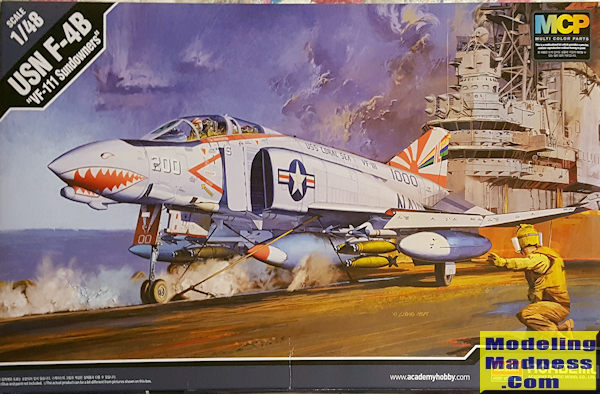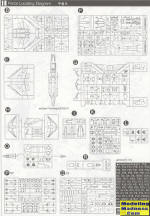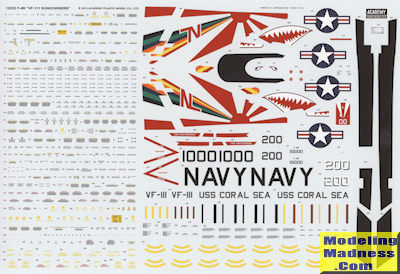
Academy 1/48 F-4B Phantom II
| KIT #: | 12232 |
| PRICE: | $45.00 which includes shipping from Korea |
| DECALS: | One option |
| REVIEWER: | Scott Van Aken |
| NOTES: | 2014 tooling |

| HISTORY |
What the Navy got was a world beater in all respects. It was blindingly fast and I have heard that the plane would run out of fuel before it stopped accelerating. It succeeded in capturing a number of records that stood until a specially modified F-15 (the Streak Eagle) was able to dash many of them. So good was the aircraft that the USAF bought a slightly modified version and it turned out that the USAF bought more than the Navy. It was also a popular aircraft for those foreign air forces that were able to maintain what was a rather sophisticated aircraft. While not this version, there are still Phantom IIs in military service nearly 60 years after its first flight.
| THE KIT |
 When Academy announced a new line of 1/48 Phantom kits in 2013, Phantom phans became very excited at the prospect of seeing these new kits. After all, the kings at the time were the Hasegawa kits, which were basically designed in the early 1980s and while still great kits, were lacking in detail in some regards. In 2014, the F-4B was released and eagerly snapped up by modelers. At last, a new tool early Phantom II with engraved panel lines for the 1/48 Modeler (The Hasegawa F-4B/N still retained its raised panel lines).
When Academy announced a new line of 1/48 Phantom kits in 2013, Phantom phans became very excited at the prospect of seeing these new kits. After all, the kings at the time were the Hasegawa kits, which were basically designed in the early 1980s and while still great kits, were lacking in detail in some regards. In 2014, the F-4B was released and eagerly snapped up by modelers. At last, a new tool early Phantom II with engraved panel lines for the 1/48 Modeler (The Hasegawa F-4B/N still retained its raised panel lines).
However, all that stuff comes at a price. Once one gets past sticker shock and gets the kit home, opening the box reveals a lot of sprues, several of them duplicates. The different colors of the plastic (white, grey and black) are also a bit odd and there seems no rhyme or reason for the white or black plastic.
So, on to what is in the box. The cockpit is quite complete and includes inserts for the instrument side consoles to allow both USAF and USN planes to be modeled. Those hoping for a proper Navy rear cockpit will be disappointed as it still has a full left console, though one does have to give them credit for trying. It also has a decent rear floor and does not tell you to install rudder pedals and control stick as with other F-4 kit. As a side note, the back seat could be rigged with these items and was used in the operational conversion squadrons. The kit does not offer decals for the instruments, something I like but others are ambivalent about. Seats are nicely done and consist of eight parts. No belts are provided, though you do get crew figures.
The instructions go almost immediately into building up the landing gear bays, each bay consisting of at least four separate walls. It then has you install the gear into these bays, correctly showing a slightly inward cant to the main gear. From what I see, this is an open invitation to break the landing gear while building the kit and makes it so much more difficult to mask when painting the underside. Anyway, we then go to assembling the wings and this is pretty straight-forward stuff. The kit provides separate outer ailerons/flaps. Speed brakes are also separate as they often bleed down once power is removed. The correct 'thin wing' and high pressure wheels/tires are also provided.
A full intake is offered and though it will be difficult to remove the seams, they are off to the inside so may not be all that noticeable when done. These fit into the lower fuselage section and the upper bit is placed atop it, trapping the intake ducts and the exhaust bits which have to be assembled and installed prior to this. The exhaust assembly also includes the inner lower rear fuselage section between the burner cans. Personally, I would see if the burner cans can be glued in after the fuselage is together, again because masking these to paint around them will be a real pain if not. The intakes themselves are just like every other F-4 kit I've built. The lower aft fuselage, which is most of the unpainted area aft of the exhaust, is separate and in a different color plastic from the rest of the fuselage. But that shouldn't be too surprising as the separate fin and stabilizers are also a different shade.
You get both slotted and unslotted stabilizers to use and Vietnam era F-4Bs generally used unslotted ones. Actually, I'm not 100% sure when the slotted ones were developed, but I do know these were standard on the F-4J and retrofitted to the B models. You cannot do an F-4N as there does not seem to be any ESM antenna on the sprues though there are unopened holes in the side of the intakes for them.
Thanks to the multi-use of common sprues, you get a lot of different IR seekers and fin tips. Several sprues are dedicated to weapons and pylons. You get the proper pointy pylons as used by USN planes along with Sidewinder rails and both a MER and TERs. Naturally, these are multiple pieces with a single TER being five pieces. There are mulitiple versions of Sidewinder included so you will be able to fill your  spares box with what you don't use. Proper wing and centerline tanks are also included. The canopy is in several sections and a boarding ladder can be installed if one wishes.
spares box with what you don't use. Proper wing and centerline tanks are also included. The canopy is in several sections and a boarding ladder can be installed if one wishes.
Academy's instructions are the map type that are similar to what Dragon and others use. The construction steps are well drawn with some detail images to be sure things are properly aligned. There is a large color chart on the front with the paints from a number of brands provided. In line with other Academy Phantom kits, there is one markings option and that is for the box art plane, the CAG bird from VF-111. You also get full stencils and markings for the various weapons. The decals are nicely printed and while the white and yellow markings seem to disappear into the backing, if the build-up images are any indication, they will be properly opaque.
| CONCLUSIONS |
With all the parts in this kit, it almost makes the Hasegawa offering look like a snap tite! No need to buy aftermarket weapons with this one and you do get a lot of detail with the kit. I'll have to gig Academy for being so stingy on the decals as a kit of this cost should have multiple options right in the box. Overall I would say that you shouldn't toss your Hasegawa Phantoms as they are still quite nice kits. This one is just that much nicer.
September 2016
Copyright ModelingMadness.com. All rights reserved.
Thanks to smart shopping credit for this one. If you would like your product reviewed fairly and fairly quickly, please contactthe editor or see other details in the